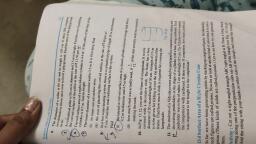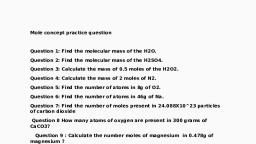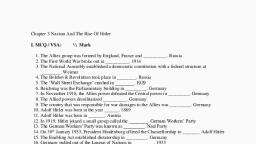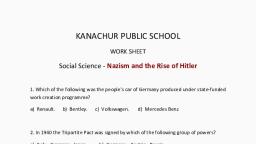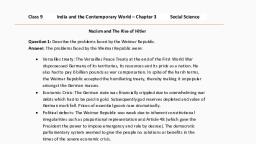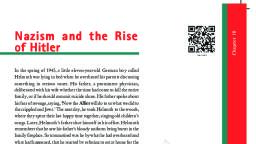Page 1 :
INDIAN SCHOOL MUSCAT, , SENIOR SECTION, DEPARTMENT OF SOCIAL SCIENCE, CLASS: IX : History, CHAPTER: 3 Nazism and Rise of Hitler, WORKSHEET No. 02, S.No., , QUESTIONS AND ANSWERS, , Marks, , 1, , Narrate the story of Helmuth . (Write answer from text book page no. 49), , 3, , 2, , Explain the circumstance in which the Weimar Republic came into existence? Why, was it not well received by the people? (CBSE 2011), , 5, , 1. The defeat of Imperial Germany in the First World War and the abdication of, the emperor gave an opportunity to parliamentary parties to recast German, polity., 2. A National Assembly met at Weimar and established a democratic, constitution with a federal structure., 3. Deputies were elected to the German Parliament or Reichstag, on the basis, of equal and universal votes cast by all adults including women., 4. This republic was not received well by its own people largely because of the, terms it was forced to accept in the Treaty of Versailles after Germany‟s, defeat at the end of the First World War., 5. Politically too the Weimar Republic was fragile. Its constitution had some, inherent defects which made it unstable and vulnerable to dictatorships., 3, , 4, , Point out the terms and conditions of the Treaty of Versailles. Why was it unjust and, harsh to Germany? (CBSE 2010, 2011), 1. The peace treaty at Versailles with the Allies was harsh and humiliating to, Germany., 2. Germany lost its overseas colonies, a tenth of its population, 13 per cent of, its territories, 75 per cent of its iron and 26 Percent of its coal to France,, Poland, Denmark and Lithuania., 3. The Allied Powers demilitarized Germany to weaken its military power., 4. The War Guilt Clause held Germany responsible for the war and damages, the Allied countries suffered and Germany was forced to pay a compensation, amounting to £6 billion., 5. The Allied armies also occupied the resource-rich Rhineland for much of the, 1920s., Examine the devastating impact of the 1st World War on Europe and Germany., (CBSE 2010), , 5, , 5, , 1. The war had a devastating impact on the entire continent both, psychologically, financially and politically. From a continent of creditors,, Europe turned into one of debtors., 2. The Weimar republic carried the burden of war guilt and those who, supported the Weimar Republic were called as the „November Criminals‟., 3. Soldiers came to be placed above civilians and the media glorified trench life., 4. Aggressive war propaganda and national honor occupied centre stage in the, public sphere., Page 1 of 8, ISM/SENIOR SECTION/ IX / SOCIAL SCIENCE /APRIL- 2017
Page 2 :
5, , 6, , 5. While popular support grew for conservative dictatorships as democracy was, indeed a young and fragile idea in Germany., Explain the growth of political radicalism in Germany after the First World War. 5, (CBSE 2009, 2015-16 ), 1. The political atmosphere in Berlin was charged with demands for Soviet-style, governance., 2. Those opposed to this – such as the socialists, Democrats and Catholics –, met in Weimar to give shape to the democratic republic., 3. The Weimar Republic crushed the uprising of Communists/ Spartacists with, the help of a war veteran‟s organisation called Free Corps., 4. The anguished Spartacists later founded the Communist Party of Germany., 5. Political radicalism was heightened by the economic crisis in Germany. Loss, of value of German currency and hyperinflation, prices of goods increased,, forcing the unemployed youth to join with radicals., What do you know about the „Dawes Plan‟? (CBSE 2012), , 3, , 1. Germany had fought the First World War largely on loans and had to pay war, compensation in gold. This depleted gold reserves of Germany., 2. With too much printed money in circulation, the value of the German mark, fell. As the value of the mark collapsed, prices of goods soared. This crisis, came to be known as hyperinflation., 3. The USA intervened and bailed Germany out of the crisis by reworking on the, terms of reparation to ease the financial burden on Germany. This US plan, came to be known as „Dawes Plan‟., 7, , Point out the challenges faced by the Weimar Republic. Why was it not well 5, received by the people?, 1. The Weimar republic carried the burden of war guilt and national humiliation, and was financially crippled by being forced to pay compensation., 2. Due to the role of Weimar Republic in signing the Treaty of Versailles the, people did not receive it well., 3. Weimar republic was highly unstable. Twenty cabinets changed in an, average 239 days !, 4. Weimar Republic could not solve the problems that arose out of the, economic crisis such as unemployment and price inflation., 5. Political radicalism was another problem faced by the Republic. The, Communists and Socialists and later Nazis had become a threat to the, Weimar Republic., 6. Those who supported the Weimar Republic, mainly Socialists, Catholics and, Democrats, became easy targets of attack in the conservative nationalist, circles. They were mockingly called the „November criminals’., , 8, , Point out the effect of the „Economic Depression‟ (1929-1932) in USA and Germany. 5, OR, How did economic depression of 1929 affect Germany? (CBSE 2011), Page 2 of 8, ISM/SENIOR SECTION/ IX / SOCIAL SCIENCE /APRIL- 2017
Page 3 :
9, , 1. The Wall Street Exchange crashed in 1929, and thus began the Great, Economic Depression from 1929-1932., 2. Over the next three years, the national income of US fell by half, factories, shut down, exports fell and farmers were badly hit by the lack of demand for, their products. The effects of recession in the US economy were felt, worldwide., 3. The German economy was worst hit by this economic crisis. German, investments and industrial recovery was largely dependent on loans from the, US. This support was stopped due to the depression., 4. The number of unemployed in Germany touched six million. As jobs, disappeared, the youth took to criminal activities., 5. People lost confidence in the democratic system (Weimar Republic) which, offered no solution to the economic crisis., „The crisis in the economy, polity and society formed the background to Hitler‟s rise 5, to power.‟ Describe., 1. Born in 1889 in Austria, Hitler spent his youth in poverty. When the First, World War broke out, he enrolled for the army and earned medals for, bravery., 2. In 1919, he joined a small group called the German Workers Party. He, subsequently took over the organisation and renamed it as the National, Socialist German Workers‟ Party. This party came to be known as the Nazi, Party., 3. In 1923, Hitler marched to Berlin to capture power. He failed, was arrested,, tried for treason, and later released., 4. It was during the „Great Depression‟ that Nazism became a mass movement., By 1932, it had become the largest party with 37 per cent votes., 5. Hitler was offered the Chancellorship in January 1933 by the German, President Hindenburg. After the death of Hindenburg, Hitler declared himself, as the President., , (Paul Von Hindenburg , President of Germany from 12 May 1925 – 2 August 1934), 10, , Discuss the reasons why Nazism became popular in Germany by 1930. (CBSE 5, 2010), 1. Discontent of people towards Weimar Democratic Republic due to political, instability and its role in signing Treaty of Versailles. People lost confidence in, democratic parliamentary system., 2. Economic crisis after First World War period and during the years of, depression. It was during this period Nazism became a mass movement., 3. Systematic Nazi propaganda could attract people towards Nazi Party., 4. Hitler‟s speech had a great effect on people. He promised to build a strong, Page 3 of 8, ISM/SENIOR SECTION/ IX / SOCIAL SCIENCE /APRIL- 2017
Page 4 :
11, , nation. These made Nazism popular in Germany by 1930., 5. Lack of unity among the Communists, Socialists and Democrats is another, factor that helped Nazism to become popular and Hitler to reach to power., “Hitler was a powerful speaker. His passion and his words moved people.” Justify 5, with any four arguments in favor of the statement., OR, „Nazi propaganda skillfully projected Hitler as a messiah, a savior ‟. Explain the, statement.(CBSE 2014), 1. Hitler promised to build a strong nation and undo the injustice of the, Versailles Treaty and restore the dignity of the German people., 2. He promised employment for those looking for work, and a secure future for, the youth., 3. He promised to weed out all foreign influences and resist all foreign, „conspiracies‟ against Germany., 4. He devised a new style of politics with rituals and spectacle in mass, mobilisation., 5. The Red banners with the Swastika, the Nazi salute, and the ritualised, rounds of applause after the speeches were all part of this spectacle of, power., , 12, , How did Hitler systematically destroy democracy in Germany once came to power in 5, 1933? (CBSE 2012), The following steps destroyed democracy completely in Germany:1. The Fire Decree of February 1933: This Decree was issued after the, destruction of the German Parliament in a mysterious fire. This Decree, indefinitely suspended civic rights like freedom of speech, press and, assembly that had been guaranteed by the Weimar Constitution., 2. The Enabling Act of March 1933:This Act established dictatorship in, Germany. It gave Hitler all powers to sideline the Parliament and rule by, decree., 3. All political parties and trade unions were banned except for the Nazi, Party and its affiliates., 4. The state established complete control over the economy, media, army, and judiciary., 5. Special security forces such as Storm Troopers, Gestapo and SS were, created to control the society the ways the Nazis wanted., , Goebbels, propaganda Minister of Hitler, Page 4 of 8, ISM/SENIOR SECTION/ IX / SOCIAL SCIENCE /APRIL- 2017
Page 5 :
13, , What are the types of special forces created by the Nazis? Mention its importance., , 5, , 1. Regular police in green uniform, the SA or the Storm Troopers; these, included the Gestapo (secret state police),, 2. Other police forces included the SS (the protection squads), the criminal, police and the Security Service (SD)., 3. It was the extra-constitutional powers of these newly organised forces that, gave the Nazi state its reputation as the most dreaded criminal state., 4. People could now be detained in Gestapo torture chambers, rounded up and, sent to concentration camps, deported at will or arrested without any legal, procedures., 5. The police forces acquired powers to rule with impunity., 14, , Examine economic policies and foreign policies of Hitler.(CBSE 2015), 5, 1. Economic Policy: Hitler assigned the responsibility of economic recovery to, the economist Hjalmar Schacht who aimed at full production and full, employment through a state-funded work-creation programme., 2. This project produced the famous German superhighways and the people‟s, car, the Volkswagen., 3. Foreign Policy: Hitler was pulled out of the League of Nations in 1933., 4. Reoccupied the Rhineland in 1936, and integrated Austria and Germany in, 1938 under the slogan, „One people, One empire, and One leader’., 5. He occupied Sudetenland and began to invade East Europe to accumulate, resources through expansion. In 1939, Germany invaded Poland, leading to, the Second World War, in which Germany was finally defeated., , 15, , Why is it considered that the plan of Hitler to attack Soviet Union was a „Historic 5, blunder‟? (CBSE 2013), 1. Hitler attacked Soviet Union in 1941 to achieve his long term aim of, conquering Eastern Europe., 2. This exposed the German Western front to British aerial bombing and, Eastern front to powerful Soviet armies., 3. The Soviet Red Army inflicted a crushing and humiliating defeat on Germany, at Stalingrad., 4. After this defeat the Soviet Red Army hounded out the retreating German, military until they reached the heart of Berlin., 5. By this the Soviet Union occupied East Germany and controlled Eastern, Europe for the next half of the century., , (Adolf Hitler (1889 – 1945 ), Page 5 of 8, ISM/SENIOR SECTION/ IX / SOCIAL SCIENCE /APRIL- 2017
Page 6 :
16, , “The crimes that Nazis committed were linked to a system of belief and a set of practices”., Analyze the statement. (CBSE 2010) OR Explain the Racial ideology of Nazis/ Hitler., , 5, , 1. According to Nazi ideology, there was no equality between people but only a racial, 2., 3., 4., , 5., , 17, , 18, , hierarchy., Blond, blue-eyed, Nordic German Aryans were at the top, while Jews were located, at the lowest rung. They came to be regarded as an anti-race, the arch-enemies of, the Aryans., All other coloured people were placed in between depending upon their external, features., Hitler‟s racism borrowed from thinkers like Charles Darwin and Herbert Spencer., The Nazis argued that the strongest race would survive and the weak ones would, perish. The Aryan race was the finest. It had to retain its purity, become stronger and, dominate the world., The other aspect of Hitler‟s ideology was related to the geopolitical concept of, Lebensraum, or living space. Hitler advocated for the annexation of other lands as, the part of his imperialistic ambition., , 5, Describe what the Nazis did for the establishment of the ‘Racial State’. (CBSE 2009), OR, In what ways did Nazi state seek to establish total control over its people? (CBSE2014), 1. Once in power, the Nazis quickly began to implement their dream of creating an, exclusive racial community of pure Germans by physically eliminating all those who, were seen as „undesirable‟., 2. Nazis wanted only „pure and healthy Nordic Aryans‟. Only they were seen as worthy, of prospering and multiplying., 3. This meant that even those Germans who were seen as impure or abnormal had no, right to exist.(The Euthanasia Programme), 4. Jews were not the only community classified as „undesirable‟. Many Gypsiesand, blacks living in Nazi Germany were considered as racial „inferiors‟ who were widely, persecuted., 5. Russians and Poles were considered subhuman. When Germany occupied Poland, and parts of Russia, captured civilians were forced to work as slave labourers., „Jews remained the worst sufferers in Nazi Germany.‟ Why?, 5, , 1. Nazi hatred of Jews had a precursor in the traditional Christian hostility towards, , 19, , Jews. They had been stereotyped as killers of Christ and usurers., 2. They were often persecuted through periodic organized violence, and expulsion from, the land., 3. Hitler‟s hatred of Jews was based on the pseudo-scientific theories of race, which, held that conversion was no solution to „the Jewish problem‟. It could be solved only, through their total elimination., 4. From 1933 to 1938 the Nazis terrorised, pauperisedand segregated the Jews,, compelling them to leave the country., 5. The next phase, 1939-1945, aimed at concentrating them in certain areas and, eventually killing them in gas chambers in Poland called „Holocaust‟., Explain the experiment of „racial utopia‟ of Nazis on Poland., 3, Answer should be written from Text book page No. 62 & 63., , Page 6 of 8, ISM/SENIOR SECTION/ IX / SOCIAL SCIENCE /APRIL- 2017
Page 7 :
20, , Evaluate the nature of schooling under Nazis. (CBSE 2012), , 5, , 1. All schools were cleansed and purified. This meant that teachers who were, Jews or seen as „politically unreliable‟ were dismissed., 2. Children were first segregated: Germans and Jews could not sit together or, play together. Subsequently, „undesirable children‟ – Jews, the physically, handicapped, Gypsies – were thrown out of schools. And finally in the 1940s,, they were taken to the gas chambers., 3. „Good German‟ children were subjected to a process of Nazi schooling, a, prolonged period of ideological training., 4. Racial science was introduced to justify the Nazi ideas of race. The Maths, classes were used to popularize the Jews and worship Hitler., 5. Even the function of sports was to nurture a spirit of violence and aggression, among children. Hitler believed that boxing could make children iron hearted,, strong and masculine., 21, , Analyze the role of youth organizations in Nazi Germany. (CBSE 2010), , 5, , 1. Youth organizations were made responsible for educating the German youth in the, „the spirit of National Socialism‟., 2. Ten-year-olds had to join Jungvolk. At 14, all boys had to join the Nazi youth, organization – Hitler Youth., 3. They learnt to worship war, glorify aggression and violence, condemn democracy,, and hate Jews, communists, Gypsies and all those categorized as „undesirable‟., 4. After a period of rigorous ideological and physical training they joined the Labour, Service, usually at the age of 18 and they had to serve in the armed forces and enter, one of the Nazi organizations., 5. The Youth League of the Nazis was founded in 1922. Four years later it was, renamed Hitler Youth. To unify the youth movement under the Nazi control, all other, youth organizations were systematically dissolved and finally banned., , 22, , „In my state the mother is the most important citizen‟. What did Hitler meant by this?, OR Explain the Nazi Cult of Motherhood. ( CBSE 2008 & 2014 ), , 5, , 1. Children in Nazi Germany were repeatedly told that women were radically different, 2., 3., 4., 5., , from men and had to maintain the purity of the race., While boys were taught to be aggressive, masculine and steel hearted, girls were, told that they had to become good mothers and rear pure-blooded Aryan children., In Nazi Germany all mothers were not treated equally. Women who bore racially, undesirable children were punished and those who produced racially desirable, children were awarded., They were given favoured treatment in hospitals and were also entitled to, concessions in shops and on theatre tickets and railway fares., To encourage women to produce many children honour Crosses were awarded. A, bronze cross was given for four children, silver for six and gold for eight or more., , Page 7 of 8, ISM/SENIOR SECTION/ IX / SOCIAL SCIENCE /APRIL- 2017
Page 8 :
23, , How was Nazi propaganda effective in creating a hatred for Jews? (CBSE 2012, 2015), , 5, , 1. The Nazi regime used language and media with care, and often to great effect for, 2., , 3., 4., 5., , popularizing its racial world view., Nazis never used the words „kill‟ or „murder‟ in their official communications. Mass, killings were termed special treatment, final solution (for the Jews), euthanasia (for, the disabled), selection and disinfections. „Evacuation‟ meant deporting people to, gas chambers., Nazis ideas were spread through visual images, films, radio, posters, catchy slogans, and leaflets., In posters, groups identified as the „enemies‟ of Germans were stereotyped,, mocked, abused and described as evil., Propaganda films were made to create hatred for Jews. The most infamous film was, „The Eternal Jew’. Orthodox Jews were stereotyped and marked., , 24, , How did the common people of Germany react to Nazism? (CBSE 2014), , 25, , 1. Many Germans saw the world through the eyes of Nazis and spoke their mind and, language. They felt hatred towards Jews and other undesirables., 2. They believed that Nazism would bring prosperity and improve the general wellbeing in Germany., 3. But not every German was a Nazi. Many organized active resistance to Nazism,, braving police repression and death., 4. The large majority of Germans were passive onlookers. They were too scared to act,, to differ or to protest., 5. Pastor Niemoeller wrote about the absence of protest among the ordinary Germans, in the face of brutal and organized crimes committed against people in the Nazi, empire. (Read poem given on page 71), Point out The Nuremberg Laws of citizenship of September 1935., 5, , 26, , What are the sources of the knowledge about the ‘Holocaust’?, , 3, , 27, , When did Mahatma Gandhi write his first letter to Hitler? What was his request to Hitler in, this letter?, What did Gandhiji write in his second letter to Hitler on a) Non-violence b) Science of, destruction c) Legacy of Hitler?, , 3, , 28, , Mention any three ways in which NAZI state sought to establish total control over its people. (CBSE, 2011), Highlight three provisions of the Enabling Act of 1933. ( CBSE 2013), Name the countries those were a part of the Allied and Axis Powers. (2015), Describe any three circumstances because of which Hitler came to power. (2015), ‘Hitler’s Germany is reputed as the most dreaded criminal state’. Justify the statement. (2016), State three features of political radicalism in Germany.(2015), Explain the impact of Hitler’s attack on Soviet Union in 1941. (2016, Mention five important consequences of Nazism on Germany.(2015), Write answers of Q. No. 1, 19, 25, 26, 27, 28, 29 , 30 31, & 32 in note book., , 3, , 29, 30, 31, 32, 33, 34, 35, , 5, , 3, 3, 3, 3, 3, 3, 5, Page 8 of 8, , ISM/SENIOR SECTION/ IX / SOCIAL SCIENCE /APRIL- 2017











